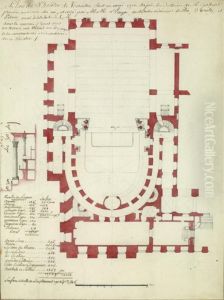Jacques-Ange Gabriel Paintings
Jacques-Ange Gabriel was a prominent French architect born on October 23, 1698, in Paris, France. He was the most influential architect of his time in France, serving as the premier architect to King Louis XV. Gabriel came from a family with a strong architectural background; his father, Jacques Gabriel, was also a well-known architect who served Louis XIV.
Gabriel's education and early career were closely tied to his father's position. He studied at the French Academy in Rome, which was a common practice among French artists and architects of the era. Upon his return to France, he worked alongside his father and eventually succeeded him as the overseer of the royal buildings.
Gabriel's style was characterized by his adherence to the classical principles and the elegance and clarity of his designs. He was a key proponent of the Louis XV style, also known as the 'Style Louis Quinze,' which was a transition from the more ornate Baroque to the neoclassical style. His works included the completion of the Place de la Concorde (originally named Place Louis XV), the École Militaire, and the Petit Trianon at Versailles.
One of Gabriel's most significant contributions to French architecture was the Petit Trianon, a small château located on the grounds of the Palace of Versailles. It was designed for Madame de Pompadour, the king's mistress, but after her death, it became the private retreat of Queen Marie Antoinette. The Petit Trianon is an excellent example of early neoclassical architecture, with its clean, simple lines and rejection of the excessive ornamentation of the Baroque style.
Gabriel also worked on several other important projects, including the creation of the Opera at the Palace of Versailles and the design of the École Militaire in Paris. His influence extended beyond individual projects, as he was responsible for the general planning of several Parisian neighborhoods and the design of public squares.
Jacques-Ange Gabriel's legacy is not only seen in the magnificent buildings he created but also in the overall urban planning of Paris during the 18th century. His architectural philosophy and his commitment to classical principles helped shape the development of neoclassical architecture in France. He died on January 4, 1782, in Paris, leaving behind a lasting impact on the architectural landscape of France.
